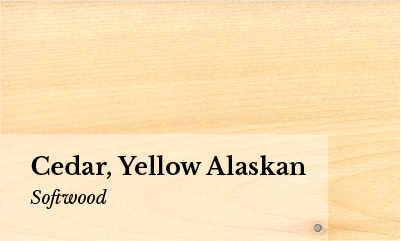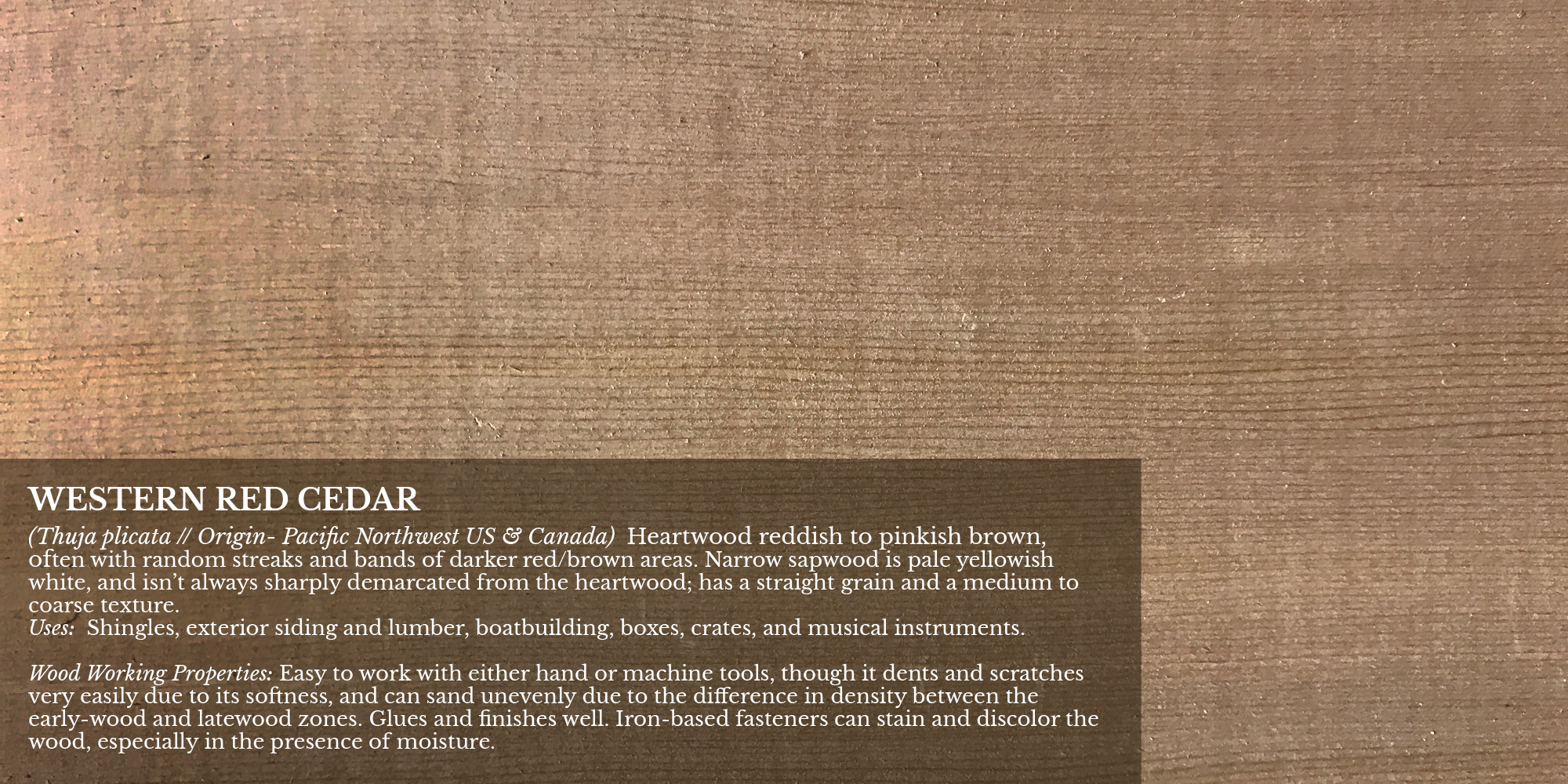Softwood Photos and Descriptions (alphabetical)
(Cupressus nootkatensis // Origin- Northwest Coast of North America) Heartwood is a light yellow. Sapwood is a similar whitish/pale yellow and isn’t distinct from the heartwood. Color tends to darken with age upon exposure to light, (though when left exposed outdoors it weathers to a uniform gray). Grain is usually straight, though sometimes wavy, with a uniform medium to fine texture.
Uses: Carving, boatbuilding, siding, flooring, decking, outdoor furniture, musical instruments (flutes, soundboards on guitars), boxes and chests, and various utility/construction applications.
Wood Working Properties: Easy to work with both hand and machine tools, though pieces with wavy grain may produce tearout during planing. Holds paint well. Stains, glues, and finishes well.
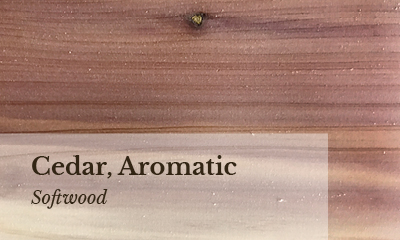
(Juniperus virginiana // Origin- Eastern North America) Also known as Eastern Red Cedar. Heartwood tends to be a reddish or violet-brown. Sapwood is a pale yellow color, and can be appear throughout the heartwood as streaks and stripes. Has a straight grain, usually with knots present. Has a very fine even texture.
Uses: Fence posts, closet and chest linings, carvings, outdoor furniture, pencils, bows, and small wooden specialty items.
Wood Working Properties: Overall, Aromatic Red Cedar is easy to work, notwithstanding any knots or irregularities present in the wood. It reportedly has a high silica content, which can dull cutters. Aromatic Red Cedar glues and finishes well, though in many applications, the wood is left unfinished to preserve its aromatic properties.
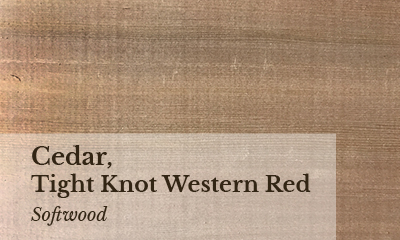
(Thuja plicata // Origin- Pacific Northwest US & Canada) Coloration and properties are the same, but Tight Knot Cedar, is simply a different grade. This is a #2 or Tight Knot Grade version of Western Red Cedar. A knotty and economical option, very popular for exterior weatherboard applications, cabinets, or interior paneling. This grade has a lot of personality and is used on siding , interior paneling and virtually any application. The knots and other natural features define the visual character of this grade. In this grade the knots are sound and tight.
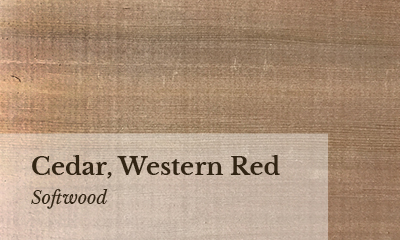
(Thuja plicata // Origin- Pacific Northwest US & Canada) Heartwood reddish to pinkish brown, often with random streaks and bands of darker red/brown areas. Narrow sapwood is pale yellowish white, and isn’t always sharply demarcated from the heartwood; has a straight grain and a medium to coarse texture.
Uses: Shingles, exterior siding and lumber, boatbuilding, boxes, crates, and musical instruments.
Wood Working Properties: Easy to work with either hand or machine tools, though it dents and scratches very easily due to its softness, and can sand unevenly due to the difference in density between the early-wood and latewood zones. Glues and finishes well. Iron-based fasteners can stain and discolor the wood, especially in the presence of moisture.
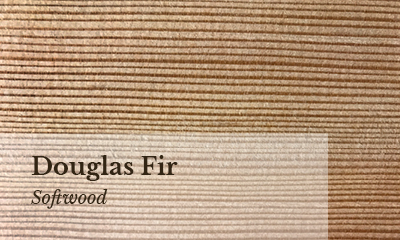
(Pseudotsuga menziesii // Origin- Western US) Can vary in color based upon age and location of tree; usually a light brown color with a hint of red and/or yellow, with darker growth rings. In quarter-sawn pieces, the grain is typically straight and plain. In flat-sawn pieces, (typically seen in rotary-sliced veneers), the wood can exhibit wild grain patterns. Grain is generally straight, though wavy or curly grain is occasionally seen; medium to coarse texture, with a decent natural luster.
Uses: Veneer, plywood, and structural/construction lumber
Wood Working Properties: Typically machines well but has a moderate blunting effect on cutters. Accepts stains, glues, and finishes well.

(Tsuga heterophylla // Origin-Northwest Coast North America) Heartwood is light reddish brown. Sapwood may be slightly lighter in color but usually isn’t distinguished from the heartwood. Occasionally contains dark streaks caused by bark maggots. The conspicuous growth rings can exhibit interesting grain patterns on flatsawn surfaces. Grain is generally straight, with a coarse, uneven texture.
Uses: Boxes, pallets, crates, plywood, framing, and other construction purposes.
Wood Working Properties: Overall working properties are good, but because of the disparity between the soft early-wood and the hard latewood, sanding can create dips and uneven surfaces. Glues, stains, and finishes well.
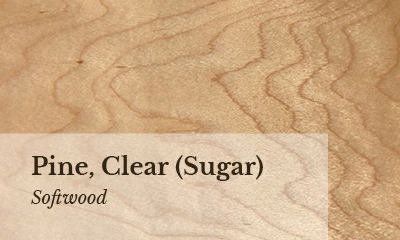
(Pinus lambertiana // Origin- Mountainous regions of Pacific coast of United States) Heartwood is a light brown, sometimes with a slightly reddish hue. Sapwood is a pale yellow to nearly white. Flatsawn surfaces frequently exhibit small brown streaks from the conspicuous resin canals present in the tree.
Wood Working Properties: Sugar Pine is easy to work with both hand and machine tools. Glues and finishes well.
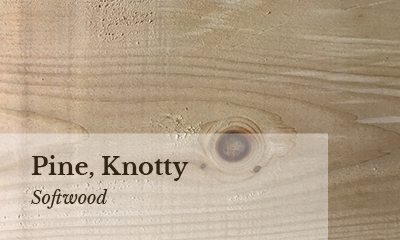
Knotty pine is not generally used in vital structural applications, because pine is a very soft wood and the knots may cause it to split, break, or bow. For decorative purposes, however, this wood is quite suitable, although it can be overwhelming when used to excess. It is particularly popular in cabins and other rural retreats, and many manufacturers of artificial wood paneling copy the distinctive bulls-eye look of knotty pine. There are over one hundred species of pine across the Northern hemisphere, and a number of species that grow in Southern climates as well. Pine trees are evergreen conifers and highly resinous, which accounts for their distinctive odor. The sap can be made into turpentine and other products, and it is quite difficult to remove from clothing or hair, so most pine used in construction is aged. Most species have scaly, grayish bark and needle-like green leaves. As the trees mature, they grow outward as well as upward, ultimately subsuming branches in their trunks, and this is how knots are formed. The scarred areas around knots are unusable for structural timber, and it’s likely that builders attempting to make use of otherwise nonfunctional wood realized the ornamental properties of knotty pine.
Knotty pine is most commonly used on walls, though it also appears in flooring. Because pine is a soft wood, floors made from it are not advisable unless they are carefully conditioned and varnished to prevent dents, scarring, and other damage.
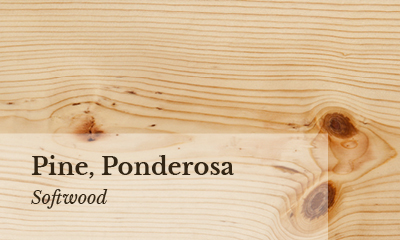
(Pinus ponderosa //Origin-Western North America) Heartwood is reddish brown, sapwood is yellowish white; Straight grained with medium texture. Although Ponderosa Pine is technically classified as a yellow (hard) pine, it shares many characteristics with white (soft) pines, having a considerably lower density than the yellow pine species found in the eastern United States.
Uses: Veneer, plywood, sheathing, subflooring, boxes, crates, posts/poles, interior trim, cabinetry, and construction lumber
Wood Working Properties: Ponderosa pine works well with both hand and machine tools. Glues and finishes well.
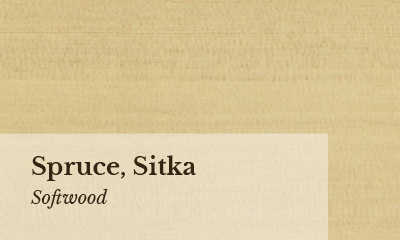
(Pinus ponderosa //Origin-Western North America) Heartwood is reddish brown, sapwood is yellowish white; Straight grained with medium texture. Although Ponderosa Pine is technically classified as a yellow (hard) pine, it shares many characteristics with white (soft) pines, having a considerably lower density than the yellow pine species found in the eastern United States.
Uses: Veneer, plywood, sheathing, subflooring, boxes, crates, posts/poles, interior trim, cabinetry, and construction lumber
Wood Working Properties: Ponderosa pine works well with both hand and machine tools. Glues and finishes well.







